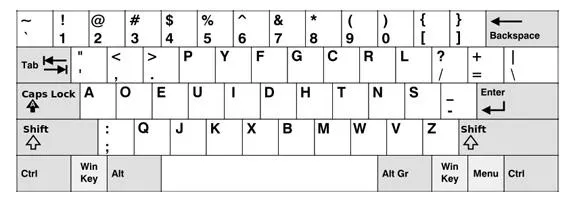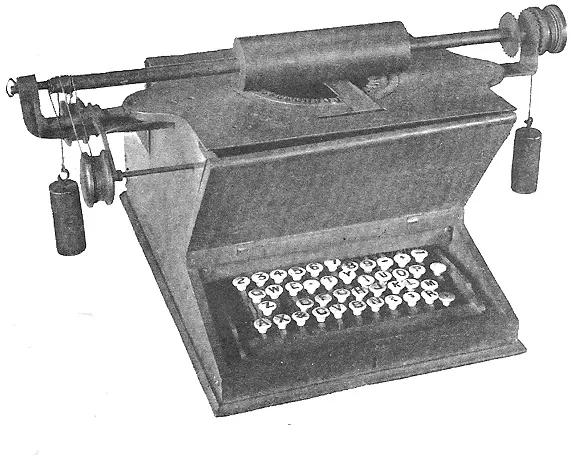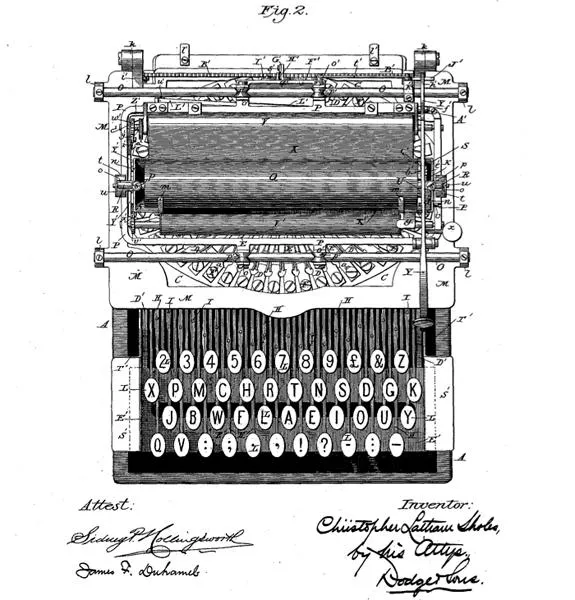Qwerty Keyboard Design Was Originally Intended To
Photodisc Getty Images In 1874 Remington Sons manufactured the first commercial typewriter called the Remington Number 1. The QWERTY keyboard was designed to place the most commonly used letters on the opposite sides of the keyboard making jamming mechanically less likely.
/https://tf-cmsv2-smithsonianmag-media.s3.amazonaws.com/filer/66/ee/66ee08a6-8daa-408c-9f11-0927f5b8cfa6/sholes-qwerty-patent.jpg)
Fact Of Fiction The Legend Of The Qwerty Keyboard Arts Culture Smithsonian Magazine
It didnt take the advent of the personal computer to create a more efficient beast.

Qwerty keyboard design was originally intended to. Legend has it that the QWERTY keyboard was also made intentionally clumsy only one vowel in the home row for instance in order to slow down typists and further reduce the possibility of jamming. At one time mechanical typewriters jammed if typists were too quick. In fact the layout was designed to help people type faster.
The English QWERTY keyboard layout was not the first layout and might not be the most efficient. BeeRaiders Radical New Keyboard. The arrangement of characters on a QWERTY keyboard was designed in 1868 by Christopher Sholes the inventor of the typewriter.
Its often said that the QWERTY keyboard is inefficient by design. The keyboard design was intended to slow down users. However Japanese researchers have debunked this myth suggesting that Sholes never intended to perpetuate a purposefully flawed design.
QWERTY cut down on this problem. The keyboard design was intended to slow down users. QWERTY cut down on this problem.
The QWERTY keyboard layout was developed in an effort to solve a peculiar mechanical problem that first appeared on early mechanical typewriters. Today we continue to use QWERTY because were accustomed to it but many experts strongly favor alternate typing approaches. The QWERTY keyboard was explicitly designed to slow typing - QWERTYs inefficiencies held a clear purpose.
Rather the layout was intended to place common two-letter combinations on opposite sides of the keyboard. The QWERTY layout is based on the keyboard design for the original typewriter. At one time mechanical typewriters jammed if typists were too quick.
The keyboard design was intended to slow down users. On manual typewriters each key is mechanically connected to a lever that has the reversed image of a letter on it. The most popular theory posits 3 that the inventors designed the QWERTY keyboard system to prevent the mechanical lock up of the strikers due to the close succession of adjacent often used keys.
Most of us were taught that the man who invented the keyboard created the QWERTY design to slow typists down. However the QWERTY keyboard layout was developed to solve a problem exhibited by some of the first. Originally however QWERTYs inefficiencies held a clear purpose.
Today we continue to use QWERTY because were accustomed to it but many experts strongly favor alternate typing approaches. The QWERTY layout is attributed to an American inventor named Christopher Latham Sholes and it made its debut in its earliest form on. If it had been put into production this article would have been about the QWETY keyboard.
After numerous iterations and a great deal of experimentation the QWERTY design finally took hold. At one time mechanical typewriters jammed if typists were too quick. - QWERTYs inefficiencies held a clear purpose.
This problem occurred whenever a typist began to type too fast and the returning key-hammer jammed with the next key-hammer traveling forward to print the follow-on character. The 1873 prototype used to demonstrate the technology to Remington The World of Typewriters By 1873 the. This typewriter was designed by Christopher Sholes and used the QWERTY keyboard we are all familiar with.
The original QWERTY keyboard was intended for hunt and peck operation and not touch-typing. Instead researchers say that the QWERTY keyboard arose. Originally patented by Christopher Sholes in 1874 this keyboard was intended to avoid jams and reduce errors by placing rarer letters in between common letters.
QWERTY cut down on this problem. As Noyes pointed out. Back in 1936 August Dvorak came up with a.
According to popular myth Sholes arranged the keys in their odd fashion to prevent jamming on mechanical typewriters by. QWERTY cut down on this problem. The faster someone typed the more often the typewriter jammed so Christopher Scholes put common letters in hard-to-reach spots.
Contrary to popular opinion the qwerty design was not actually invented to slow typists down. This popular theory was just debunked. The QWERTY keyboard was explicitly designed to slow typing- QWERTYs inefficiencies held a clear purpose.
That may explain the well-known practical. Touch-typing was a later invention. At one time mechanical typewriters jammed if typists were too quick.
Several alternatives have emerged but never replaced QWERTY as the standard. But only for so long. The keyboard design was intended to slow down users.
By modern standards the QWERTY keyboard is not the most efficient. The QWERTY design which first appeared in the 1870s separated some of the problem keys and in some sense made the process of typing more efficient. Too-fast typing was leading to keys jamming in the early days of mechanical keyboards so Remington decided to mix the letters up and slow typists down.

Fact Of Fiction The Legend Of The Qwerty Keyboard Arts Culture Smithsonian Magazine

Did You Know Techfact93 Tech Updates Keyboard Protector Midi Keyboard

Fact Of Fiction The Legend Of The Qwerty Keyboard Arts Culture Smithsonian Magazine

Fact Of Fiction The Legend Of The Qwerty Keyboard Arts Culture Smithsonian Magazine
Post a Comment for "Qwerty Keyboard Design Was Originally Intended To"